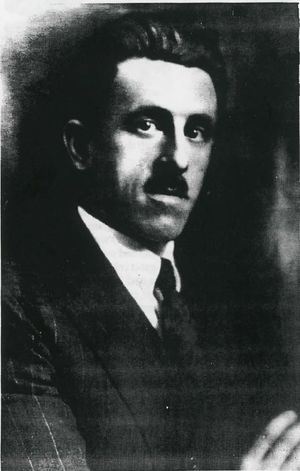Albert D. Silva
- Birthdate
- 1888/08/09
- Death date
- 1954/02/14
- Associated organizations
- Atwater Kent
- Fields of study
- Radio
Biography
Albert D. Silva who was born on August 9, 1888 to Albert and Sarah Silva. One of eight children, he was educated in Newport, Kentucky where he graduated from high school. From there he attended the University of Kentucky for one year, and in 1908 he enrolled in the Ohio Mechanics Institute in Cincinnati. Upon completion of that school he went to Schenectady to the General Electric Training School which he finished in 1911. General Electric hired him that year and assigned him to the Transformer Division in Cincinnati. By 1913 he was transferred to the Illuminating Division in Cleveland. At GE he acquired the nickname "Duke" which was to remain with him the remainder of his life.
In 1917 he was sent to Ft. Benjamin Harrison in Indianapolis, Indiana where he received a commission as a Lieutenant in the Signal Corps. His first assignment was at Camp Alfred Vail in New Jersey. Later renamed Fort Monmouth, Camp Alfred Vail was intended to provide laboratories for the Signal Corps when their facilities at the Bureau of Standards in Washington became inadequate. Along with other scientists and technicians, Silva produced copies of Allied radios, improved on previous designs and provided drawings and specifications for the various manufacturers of official Signal Corps sets.
After completing the Army's Signal School in 1918, Silva was sent over to be a part of the Signal Corps American Expeditionary Forces in Paris. Silva met Major Armstrong and became friends with him. Silva was placed in charge of the Tank Corps of the AEF and designed a modified E-10 series used in connection with a trailing antenna so the tanks could communicate with one another. After considerable experimental work, Capt. Webb left for the United States produce the radio set. Work was continued by Silva and Sergeants Pressley and Newell, and considerable improvements were made in the antenna current output. Using Armstrong's idea of a circuit employing one tube as an oscillator and one or more tubes as power amplifiers, the apparatus was successfully installed in a Renault signal tank. The antenna used was similar in construction to a Bristol rod and extended 15 ft. above the tank. Later it was felt that an umbrella antenna 6 ft. high with arms of 4 feet in length was equally as satisfactory.
On March 25, 1919 to April 5, 1919 Silva returned to the US and was assigned to the Office of the Chief Signal Officer in Washington D.C. and resigned from the Army. From December 1919 to May 12, 1922 he was the civilian in charge at Camp Alfred Vail. Shortly after leaving his civilian job he was employed by Atwater Kent as an engineer.
By 1924, Hazeltine had developed a system to neutralize the triode vacuum tube and he formed the Independent Radio Manufacturers association to compete against RCA. Atwater Kent, like many other manufacturers could not afford to pay royalties. Silva designed an amplifying apparatus for Atwater Kent, filed July 26, 1924 and awarded patent number 1,885,301 on December 4, 1934. He applied for other patents (1,983,047, 1,966,805) which would include the biasing of the grid with respect to the cathode as modification and providing for shunt resistances and capacitances across the grid circuits in parallel to the grid tuned circuits.
Silva distinguished himself at Atwater Kent and he and Atwater were very good friends. On June 21,1933 he applied for another patent just about the time manufacturers began putting radios into automobiles. One essential part of automobile radio was a power supply that could deliver the dc voltages for the tubes from battery power. Silva invented what is known as a vibrator, or mechanical rectifier in his Patent No. 1,960,599, which was used in Atwater Kent auto radios.
Faced with stiff competition and shrinking profit margins, Atwater Kent closed in 1936. Noblitt-Sparks hired Silva, and he was instrumental in launching Noblitt-Sparks in the home entertainment field. Silva designed a complete line of radios from a two tube "Mighty-Mite" to large consoles. The only patent A. D. Silva applied for while at Noblitt Sparks was 2,166,613, filed October 13, 1936 and consisted of transformers of the type used in coupling adjacent stages. Each winding was made to be adjusted to vary its inductance and thereby tune the associated circuit with respect to the mutual inductance of one coil to the other. Silva left Noblitt Sparks in 1945 to form the Columbus Process Company also located in Columbus, Indiana. One of the first contracts was to tropicalize equipment for the Signal Corps. They applied an anti-fungal treatment for apparatus destined for the Pacific. As soon as these ran out the Columbus process Company set up its production to make parts for the radio industry. In 1950 they added another 5,000 square feet for a total of 25,000 square feet. Among the products were output transformers, television transformers, power transformers, vibrator transformers, vertical choke transformers and battery charger transformers. All of the output transformers on RCA's 45 rpm record players were from Columbus Process Company. At peak capacity they had 300 employees and were productivity 10,000 transformers a day.
Albert D. "Duke" Silva died February 14, 1954.
